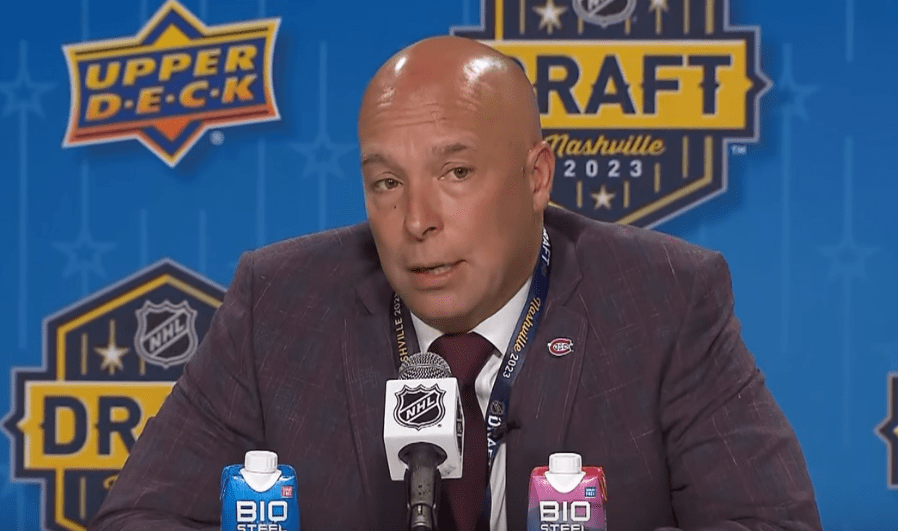Montreal Canadiens
Montreal Canadiens Looking To Make Best of LTIR Situation

The Montreal Canadiens have done a good job in clearing out significant salaries over the last few seasons, but their salary cap outlook is far from ideal.
General Manager Kent Hughes has spoken at length about not wanting to strap his club with significant contracts moving forward, outside of signing his young core like Nick Suzuki (by his predecessor) or Cole Caufield.
Instead, they’ve added short-term contracts for assets in order to maximize their LTIR space, since getting under the cap by $10.5M, thanks to Carey Price’s behemoth of a contract, is extremely difficult in a flat cap situation.
They’ll be using LTIR again this season to sustain their roster, and will likely look to add salary throughout the season to maximize their given relief pool into assets for their rebuild.
Although it seems fine and dandy in context and looks like the Canadiens have significant room to wheel and deal, it also comes with its own set of challenges.
The Carey Price Effect
Over the last few years teams like the Tampa Bay Lightning and the Vegas Golden Knights have fiddled around in Long-Term Injury Reserve (LTIR) to sustain their rosters and even push the boundaries of the NHL’s CBA.
The issue with Carey Price’s contract is that it won’t expire until the summer of 2026; meaning the Canadiens will have to work around his $10.5M price tag.
Unlike Shea Weber’s front-loaded, 13-year contract, Price’s deal still holds a significant amount of money throughout the entirety of the deal; paying him $23.5M over the next three years. When Weber was traded, he only had $6M left to be paid over four years; which will make moving Price before the 2025-2026 season close to impossible.
So what? Can’t the Montreal Canadiens just go on LTIR then?
Not that simple, especially for a rebuilding team.
With more and more top picks coming through the ranks, those players will have performance bonuses attached to their entry-level contracts and that could be a problem.
If the Canadiens were to just spend to the max and dive into LTIR, any accrued bonuses would carry over to the following season; prolonging the Canadiens’ cap woes.
Case in point, the Canadiens were dinged this season with a $1.17M cap penalty for bonuses earned during the 2022-2023 season.
Now imagine next year when you have the likes of Juraj Slafkovsky ($3.5M), Kaiden Guhle ($420K), Sean Farrell ($557K) and David Reinbacher ($1M) or more crack the team next season. That could be a lot of potential overage penalties if the Canadiens are close to the cap or using LTIR next season.
And if it wasn’t already problematic, performance bonuses also become an issue when it comes to calling players up from Laval or in other leagues.
LTIR Performance Bonus Pool
At the beginning of the year, teams not only set their LTIR pool, but also a performance bonus pool.
An LTIR performance bonus pool is established by adding up all the potential performance bonus of the players that make the opening 23-man roster.
Last season, the amount of the Canadiens’ performance bonus pool was determined at the start of the year, when Slafkovsky, Guhle, Harris and Cole Caufield all made the starting roster, giving them over $4.6M in performance bonus space.
This season, Slafkovsky ($3.5M), Guhle ($425K) Justin Barron ($275K) and Sean Monahan ($15K) have performance bonuses tied to their contract; which would give the Canadiens a performance bonus pool of roughly 4.2M if all the players make the club.
However, if the Canadiens would then need to recall a player from Laval like Sean Farrell, who has a salary of $897,500 and $557,500 in potential performance bonuses, you would need to tack on his performance bonus to his salary; meaning he would go from a cap ht of $897,500 to $1.258M because the Canadiens wouldn’t have the necessary LTIR performance bonus space.
To give you another example of such a situation, let’s go back to April 2021, when Cole Caufield joined the Canadiens at the tail-end of the season.
Because the Montreal Canadiens didn’t have a performance bonus cushion, Caufield’s cap hit rose from $880,000 to $1.3M; which is his maximum cap hit (salary + performance bonuses).
If the Canadiens had some performance bonus room, Caufield would only have counted for $880,883 against the cap and would have been able to insert in the roster much sooner than the final 10 games of the season (remember how long the Canadiens had to wait?).
Make The Best Of a Bad Situation
Despite having one of the highest payrolls in the NHL, the Montreal Canadiens seem set for a difficult year according to recent NHL betting odds, with bookies predicting another bottom-10 finish; and some even seeing a return to the bottom five.
Nonetheless, Kent Hughes remains one of the most active GMs in the league in trying to do everything little move imaginable to improve the roster.
The Canadiens’ willingness to dive into LTIR this season means that they could weaponize the remaining space in order to facilitate trades, despite only having one retention slot left.
The injury to Christian Dvorak means that, for the first time since becoming general manager of the Canadiens, Hughes will be able to begin the season without Carey Price on LTIR; and will then have the luxury to place him on LTIR if an advantageous cap-based deal comes about.
It’s not ideal in any sense, especially with the risk of performance bonus overages and the limitations it places on call-ups from Laval, but the Canadiens seem primed to make the best out of the situation.
*For more NHL betting lines and futures, head over to FanDuel.









